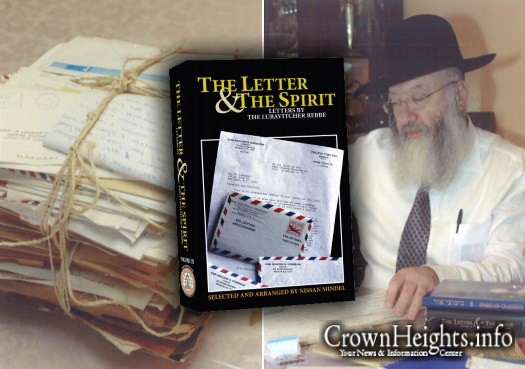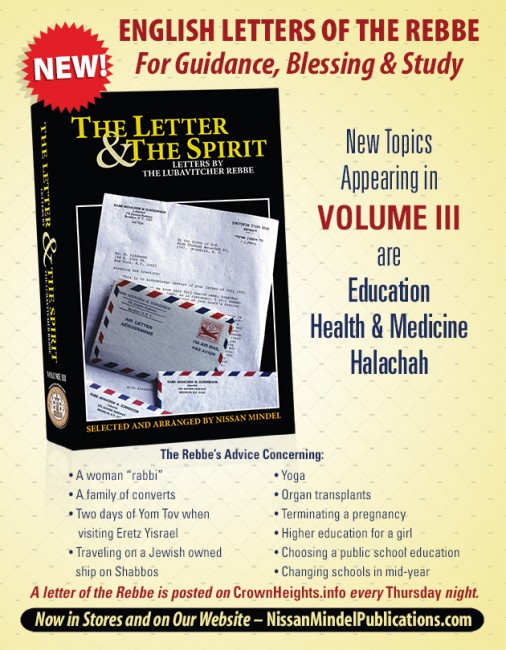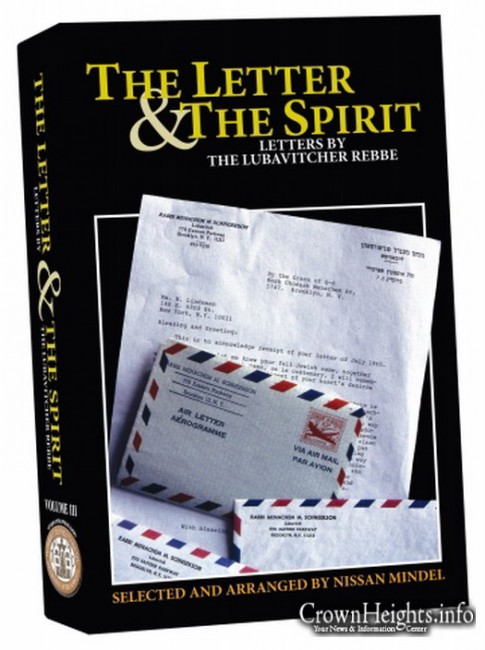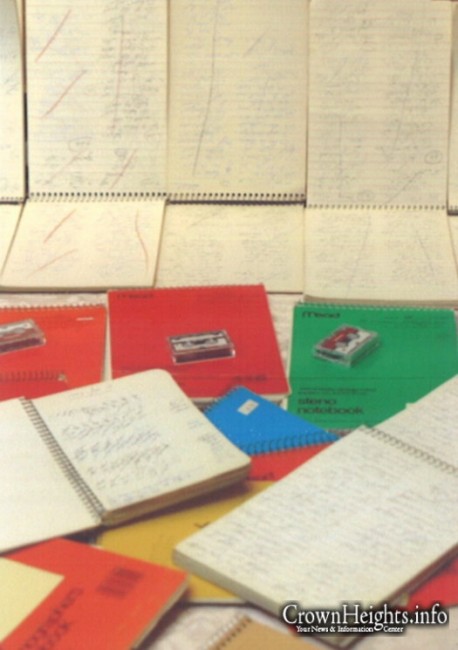
Third Volume of The Letter and the Spirit in Stores
Nissan Mindel Mindel publications, directed by Rabbi Sholom and Frida Shapiro, has released a third volume of the popular series The Letter and the Spirit, containing a wide array of the Rebbe’s letters from the archives of Rabbi Dr. Nissan Mindel, a personal secretary to the Previous Rebbe and The Rebbe, whose responsibilities included the Rebbe’s correspondence in English.
What is The Letter and the Spirit?
The Letter and the Spirit is a ten-volume compendium of the Rebbe’s English correspondence.
Who prepared the material for publication?
Rabbi Dr. Nissan Mindel o.b.m – personal secretary of the Rebbe from 1950 until 1994, appointed by the Frierdiker Rebbe to his numerous positions in the service of the Rebbeim and of Chabad, which he faithfully carried out from 1938 until his passing in 1998. He is the one who selected, categorized and prepared the letters for publication, for The Letter and the Spirit series.
How many of the ten volumes have been printed to date?
Volumes One and Two were printed in 1998 & 2013 respectively and Volume Three is soon coming out in honor of Yud Alef Nissan, 5776/2016, b’h.
Are these letters originally written in English or are they a translation from the Hebrew or Yiddish?
All the letters in The Letter and the Spirit series are originally written in English – they arenot a translation from another language.
This seems to be quite a unique phenomenon isn’t it? – that the Rebbe wrote in the spoken language of the people of the day, English.
Yes, indeed. With rare exceptions, Gedolim in Jewish history have written their holy works in the Holy tongue. Among these exceptions is the Rambam, who wrote some of his works in the language of the people, Arabic. Similarly, the fact that the Rebbe wrote a good portion of his letters in English reflects a sense of reaching out and connecting with the hamon am, meeting an urgent need. It was indeed Moshe Rabbenu who wrote the Torah in seventy languages, showing the universal quality of Torah and paving the way for the light of Torah to shine everywhere.
What distinguishes The Letter and the Spirit from other books of the Rebbe’s letters?
The Letter and the Spirit series is unique in that it was prepared by the “royal scribe” himself, the one entrusted with the Rebbe’s letters in four languages, straight from the source. For a brief period in the early years, another secretary assisted with the Rebbe’s correspondence, charged with some of the more standard Hebrew and Yiddish letters. Otherwise, Rabbi Mindel was the exclusive personal secretary during the entire period of the Rebbe’s leadership – in charge of the Rebbe’s correspondence in English, Yiddish, Hebrew and Russian.
What advantages then does The Letter and the Spirit have over other books of the Rebbe’s English correspondence?
The greatest advantage is that Rabbi Mindel undertook this project with the Rebbe’s consent and blessings. It is known that the Rebbe took a personal interest and involvement in Rabbi Mindel’s works in general. Another advantage is that Rabbi Mindel’s is the most comprehensive collection of the Rebbe’s letters, being that the Rebbe had given him to keep a copy of every letter which was written. He therefore had a large selection to choose from and was better able to choose wisely, letters which would benefit the many.
An additional advantage is the fact that Rabbi Mindel was familiar with the Rebbe’s letters and more than anyone else, understood not only their meaning but their underlying meaning as well. Having worked with the Rebbe on the letters makes him most suitable to compile such a project and to adhere to the Rebbe’s strict standards (such as confidentiality etc.).
A further plus is the skill with which Rabbi Mindel prepared these volumes. The same brilliant skills which served him well in the countless books for young and old which he authored over the decades are evident in The Letter and the Spirit compendium. He does not merely choose letters and combine them into books – he carefully categorizes them by subject and adorns them with an in-depth General Introduction (a study in itself) in addition to the Highlights (introductions) which he wrote for each individual section. Very user-friendly.
How are the letters categorized?
Rabbi Mindel categorized the letters by subject as well as chronologically.
What subjects are included in The Letter and the Spirit?
Subjects include: Perplexed, Holy Land, Concepts, Family, Lubavitch Derech, Torah and Science, Miscellaneous, Education, Health and Medicine and Halacha. Future volumes will have more letters on these subjects as well as new subjects – such as Women and Communal and Political Issues.
The Letter and the Spirit III includes three new subjects – Education, Health and Medicine and Halacha.
How has The Letter and the Spirit been received?
The Letter and the Spirit has been received with tremendous enthusiasm and encouragement from many quarters.
The Rebbe’s letters are understandably of great practical value to many people in ordering their daily life – extending advice, encouragement and blessings. So in this sense, the letters continue to guide and to bless.
Not only that, but the letters also serve as a rich and refreshing source of Torah learning, especially chassidus. As the secretary shares in his General Introduction to The Letter and the Spirit – when he would come in to the Rebbe for dictation (twice, three times a week), the experience was similar to listening to miniature sichos/Chassidic discourses. It never ceased to amaze him how the Rebbe would compose a brief letter using concepts and ideas, often lofty ones, from Chassidic sources and weave them seamlessly into a clear, brief and practical answer to the inquiry. Many are studying the letters as they would study any other Torah sefer.
Why English letters?
English letters are able to reach a much wider segment of Jews – who would normally not be able to read them in Yiddish or Hebrew. And interestingly, their universal appeal has drawn non-Jews as well to their wisdom. This is perhaps why Rabbi Mindel had chosen to promote the English letters of the Rebbe, so as to have the maximum hafatza in spreading the fountains of Chassidus to the world at large.
It was, after all, Rabbi Mindel’s proficiency in the English language which had initially drawn the Frierdiker Rebbe to him while still in Europe in the late 1930’s – a talent which the Rebbe wanted and encouraged him to use in the opening up of Chassidus to the world. It was at that time – when the Frierdiker Rebbe with his holy vision was already setting the ground work for his revolutionary efforts of hafatza on a global scale – that he enjoined Rabbi Mindel to translate the Tanya to English (a historical achievement which he b’h completed 20 years later) and to write a monthly magazine for children in English, the Talks and Tales, which he did for the next 47 years. The Rebbe himself checked every issue before it went to print throughout the 47 years.
Once these groundbreaking works were accomplished – the fountains of Chassidus burst out with unprecedented force as Rabbi Mindel’s writings were translated to many other languages and were reaching more and more people. Not only that, but other talented and prominent Chabad scholars and writers continue to benefit from the foundation which Rabbi Mindel’s works provided as we can see in the blessed results of the proliferation of Chassidic literature today.

















